I was vacationing in the Pacific Northwest for 2 weeks in July so my eyes and ears are filled with the sensations and memories of elsewhere.
So I relied on the 3 drip irrigation systems at home watering over 100 plants. Marie was spared the burden of mass watering.
The most frustration is due to squirrels eating the ripening tomatoes.
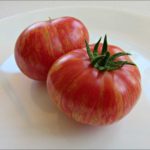 The Vintage Wine plant next to the house escaped the squirrel feast. Vintage Wine. It looks similar to a red zebra but isn’t. A wonderful new addition to your garden. Pink with gold-striped, pastel-hued, 1 lb. tomato with pronounced, elegant sweet delicious flavor. Tall potato-leaf plant producing lots of fruit
The Vintage Wine plant next to the house escaped the squirrel feast. Vintage Wine. It looks similar to a red zebra but isn’t. A wonderful new addition to your garden. Pink with gold-striped, pastel-hued, 1 lb. tomato with pronounced, elegant sweet delicious flavor. Tall potato-leaf plant producing lots of fruit
Days: 84. Size: Indeterminate. Color: Bi-Colored
Season: Mid-Season
 Padrón peppers (Spanish: pimientos de Padrón) are a variety of peppers (Capsicum annuum) from the municipality of Padrón in the province of La Coruña, northwestern Spain. These are small peppers, with a color ranging from bright green to yellowish green. Their peculiarity lies on the fact that, while their taste is usually mild, a minority (10-25%) are particularly hot. Whether a given pepper ends up being hot or mild depends on the amount of water and sunlight it receives during its growth. The peppers are customarily fried in oil and served as tapas. See Fried Padron Pepper recipe
Padrón peppers (Spanish: pimientos de Padrón) are a variety of peppers (Capsicum annuum) from the municipality of Padrón in the province of La Coruña, northwestern Spain. These are small peppers, with a color ranging from bright green to yellowish green. Their peculiarity lies on the fact that, while their taste is usually mild, a minority (10-25%) are particularly hot. Whether a given pepper ends up being hot or mild depends on the amount of water and sunlight it receives during its growth. The peppers are customarily fried in oil and served as tapas. See Fried Padron Pepper recipe
 You could drive a truck over this long-lived awesome perennialwithout doing more harm than breaking a few branches. Tough as nails & long-lived, it’s heat & drought tolerant, deer & snail resistant.Want more? Okay, lots of bright truest royal blue “Forget-Me-Not” flowers display for months on sturdy multi-branching stems. When it’s finished, cut it back to the foliage for a second performance as good as the first! Not fussy about soil but a yearly addition of compost gets a fantastic result. Popular with swallowtails!Grows to 4’ tall by 3’ wide.
You could drive a truck over this long-lived awesome perennialwithout doing more harm than breaking a few branches. Tough as nails & long-lived, it’s heat & drought tolerant, deer & snail resistant.Want more? Okay, lots of bright truest royal blue “Forget-Me-Not” flowers display for months on sturdy multi-branching stems. When it’s finished, cut it back to the foliage for a second performance as good as the first! Not fussy about soil but a yearly addition of compost gets a fantastic result. Popular with swallowtails!Grows to 4’ tall by 3’ wide.
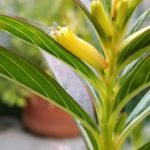 Cuphea micropetala (aka Giant cigar plant, candy corn plant. This tough and easily grown rhizomatous perennial produces tall spikes of 1-2″ tubular flowers that open yellow and then fade to orange and red and are born on tall sturdy stems to 4’H. Giant Cigar typically flowers in late summer and fall, just in time for migrating Hummingbirds. Moderately drought tolerant once well-established. To 4’ x 5’, cut back to 1.5’ tall in Winter to maintain a smaller shape.
Cuphea micropetala (aka Giant cigar plant, candy corn plant. This tough and easily grown rhizomatous perennial produces tall spikes of 1-2″ tubular flowers that open yellow and then fade to orange and red and are born on tall sturdy stems to 4’H. Giant Cigar typically flowers in late summer and fall, just in time for migrating Hummingbirds. Moderately drought tolerant once well-established. To 4’ x 5’, cut back to 1.5’ tall in Winter to maintain a smaller shape.
 Globe amaranth plants are native to Central America. They grow from 6 to 12 inches high. They have fine white hairs covering young growth, which matures to thick green stems. The leaves are oval and arranged alternately along the stem. The blooms of globe amaranth start in June and may last until October. The flower heads are clusters of florets that resemble large clover flowers. They range in color from pink, yellow, white and lavender. The flowers dry well.
Globe amaranth plants are native to Central America. They grow from 6 to 12 inches high. They have fine white hairs covering young growth, which matures to thick green stems. The leaves are oval and arranged alternately along the stem. The blooms of globe amaranth start in June and may last until October. The flower heads are clusters of florets that resemble large clover flowers. They range in color from pink, yellow, white and lavender. The flowers dry well.
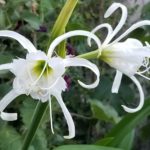 Hymenocallis is a wonderful genus of bulbous amaryllis…native mostly to the US, Mexico, and Central America. Hymenocallis (spider lilies) are an easy-to-grow moisture-lover that are a reliable perennial wildflower in the garden. Spider lilies are a tough, low maintenance plant which makes it perfect for rain gardens. Hymenocallis produce unusual white, spider-like, nocturnally fragrant flowers that are large enough to see from quite a distance. Hymenocallis is definitely a “gotta have it” plant. try growing your spider lily next to dahlia, buddleia, sarracenia, sabatia, or hibiscus. Note: The bulb is enormous! You need at least a 5 gallon container.
Hymenocallis is a wonderful genus of bulbous amaryllis…native mostly to the US, Mexico, and Central America. Hymenocallis (spider lilies) are an easy-to-grow moisture-lover that are a reliable perennial wildflower in the garden. Spider lilies are a tough, low maintenance plant which makes it perfect for rain gardens. Hymenocallis produce unusual white, spider-like, nocturnally fragrant flowers that are large enough to see from quite a distance. Hymenocallis is definitely a “gotta have it” plant. try growing your spider lily next to dahlia, buddleia, sarracenia, sabatia, or hibiscus. Note: The bulb is enormous! You need at least a 5 gallon container.
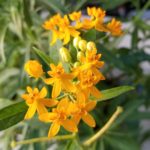 Milkweed is the only food source for Monarch Caterpillars and are a mixture of the best nectaring plants for all butterflies. Natural Bridges State Park is just over the mountains in Santa Cruz and is a major destination of the Monarch butterflies.
Milkweed is the only food source for Monarch Caterpillars and are a mixture of the best nectaring plants for all butterflies. Natural Bridges State Park is just over the mountains in Santa Cruz and is a major destination of the Monarch butterflies.
Known to have some medicinal value as a cough expectorant, the plant’s milky white sap can also cause irritation if it comes into contact with your eyes. Asclepias contain cardiac glycosides that are poisonous to humans.
 Here is a butterfly visiting our tomato plants. That’s all I know for now.
Here is a butterfly visiting our tomato plants. That’s all I know for now.
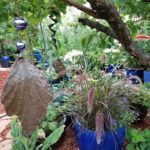 There are over 30 plants visible in this photo. Apricot, cherry, fig, flowering plum, trumpet vine, bower vine, feather grass, I was taking a photo of the yard ornaments. The copper elements get a warm patina over the years. The glass marbles continue to shine.
There are over 30 plants visible in this photo. Apricot, cherry, fig, flowering plum, trumpet vine, bower vine, feather grass, I was taking a photo of the yard ornaments. The copper elements get a warm patina over the years. The glass marbles continue to shine.

 We have a chile plant with red peppers that are best dried and then ground into a powder.
We have a chile plant with red peppers that are best dried and then ground into a powder.

![]() Sprite is one of the best grape tomatoes. And if you love grape tomatoes and do not have the space for bigger indeterminate plants this tomato variety is perfectly suited to small gardens and patio gardening. It produce short, very productive , regular-leaf tomato plants that yield small brilliant red, oval grape tomatoes borne in large numbers with refreshingly sweet flavors. Just like the original grape tomatoes these have thin skins and are packed with sweet juice. Produces tomatoes continuously all season until first frost. An early season tomato. Excellent in salads or eating fresh.
Sprite is one of the best grape tomatoes. And if you love grape tomatoes and do not have the space for bigger indeterminate plants this tomato variety is perfectly suited to small gardens and patio gardening. It produce short, very productive , regular-leaf tomato plants that yield small brilliant red, oval grape tomatoes borne in large numbers with refreshingly sweet flavors. Just like the original grape tomatoes these have thin skins and are packed with sweet juice. Produces tomatoes continuously all season until first frost. An early season tomato. Excellent in salads or eating fresh.
 Hot Lips Salvia is a hybrid and is neither a true Autumn Sage or Little Leaf Sage but offers the best of both and attracts a variety of pollinators including hummingbirds, butterflies, and larger bees. Spikes of red lipped, pure white or occasionally solid red, tubular blooms are borne continuously from spring to fall on this durable drought and heat tolerant perennial salvia. It creates a mounding upright to spreading plant that loves the heat and sun.
Hot Lips Salvia is a hybrid and is neither a true Autumn Sage or Little Leaf Sage but offers the best of both and attracts a variety of pollinators including hummingbirds, butterflies, and larger bees. Spikes of red lipped, pure white or occasionally solid red, tubular blooms are borne continuously from spring to fall on this durable drought and heat tolerant perennial salvia. It creates a mounding upright to spreading plant that loves the heat and sun.

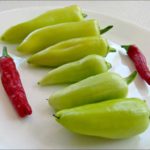 Hungarian Hot Wax 75-80 days. Dependable and productive northern variety. Short, stocky plants bear 4-6” upright, hot yellow fruits that ripen to bright orange-red. Festive in the garden. Plants grow 16-20 inches tall. Peppers are great on the grill, sauted into omelets or eaten fresh. Spicy, fairly hot banana shaped fruits, 6″ long and 1-1/2″ across – perfect for pickling. Matures from light yellow to bright red. Best hot pepper for cooler climates. Ever-bearing plants are 16 to 24″ tall, strong, upright. Scoville Rating: 5,000 to 10,000
Hungarian Hot Wax 75-80 days. Dependable and productive northern variety. Short, stocky plants bear 4-6” upright, hot yellow fruits that ripen to bright orange-red. Festive in the garden. Plants grow 16-20 inches tall. Peppers are great on the grill, sauted into omelets or eaten fresh. Spicy, fairly hot banana shaped fruits, 6″ long and 1-1/2″ across – perfect for pickling. Matures from light yellow to bright red. Best hot pepper for cooler climates. Ever-bearing plants are 16 to 24″ tall, strong, upright. Scoville Rating: 5,000 to 10,000
 This season we moved the Hydrangea pot further away from the house so it gets several more hours per day of sunlight. It is responding. I try each year to boost the acidity of the soil in an attempt to get the blues that I see in all the hydrangeas every summer in Seattle.
This season we moved the Hydrangea pot further away from the house so it gets several more hours per day of sunlight. It is responding. I try each year to boost the acidity of the soil in an attempt to get the blues that I see in all the hydrangeas every summer in Seattle.
 This is another tuberous begonia. This first season for this variety.
This is another tuberous begonia. This first season for this variety.
 Marjoram (Origanum majorana) is an easy to grow herb well suited for growing in containers as well as the garden. There are generally three varieties that are commonly grown: sweet marjoram, pot marjoram, and wild marjoram (also known as common oregano). All types of marjoram are popular for use in the kitchen as seasoning for numerous dishes. They’re also grown for their enticing fragrance.
Marjoram (Origanum majorana) is an easy to grow herb well suited for growing in containers as well as the garden. There are generally three varieties that are commonly grown: sweet marjoram, pot marjoram, and wild marjoram (also known as common oregano). All types of marjoram are popular for use in the kitchen as seasoning for numerous dishes. They’re also grown for their enticing fragrance.
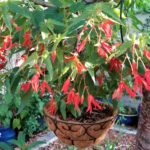 Watsonia bulbs, also known as bugle lily plants, are related to the Lily family and native to South Africa. While they prefer warm climates, they can survive in USDA zone 8. These delicate flowering bulbs usually come in a range of orange and peach hues. As a garden plant, Watsonia blooms in midsummer, providing subtle coloring to a flower border and attracting both hummingbirds and pollinating insects. These lovely flowers rise on spikes from thick sword-like leaves about 18 inches long. Flowers soar almost a foot above the foliage and may be orange, red, pink, coral, white or yellow. Blooms are 3 inches long and last several weeks, making them an attractive cut flower.
Watsonia bulbs, also known as bugle lily plants, are related to the Lily family and native to South Africa. While they prefer warm climates, they can survive in USDA zone 8. These delicate flowering bulbs usually come in a range of orange and peach hues. As a garden plant, Watsonia blooms in midsummer, providing subtle coloring to a flower border and attracting both hummingbirds and pollinating insects. These lovely flowers rise on spikes from thick sword-like leaves about 18 inches long. Flowers soar almost a foot above the foliage and may be orange, red, pink, coral, white or yellow. Blooms are 3 inches long and last several weeks, making them an attractive cut flower.
 Society garlic is an attractive ornamental plant from South Africa whose leaves have a garlicky odor. It belongs to the lily family — as do onions and garlic — but to a different genus container. Each plant has only five or six leaves 1 foot long by 1/4 inch wide arising from a bulb, and doesn’t make much of a splash. However, a clump of individuals gives the effect of a much larger plant. The leaves of the species are grayish-green. A leafless stalk 1 or 2 feet tall holds seven to 20 flowers above the foliage in an umbel. The flowers are much showier than those of regular garlic. The blooms are urn-shaped, about 3/4 inch long. Six petals, each about 3/8 inch long, flare out from the top of the “urn,” and six tiny scales form a corona within its throat
Society garlic is an attractive ornamental plant from South Africa whose leaves have a garlicky odor. It belongs to the lily family — as do onions and garlic — but to a different genus container. Each plant has only five or six leaves 1 foot long by 1/4 inch wide arising from a bulb, and doesn’t make much of a splash. However, a clump of individuals gives the effect of a much larger plant. The leaves of the species are grayish-green. A leafless stalk 1 or 2 feet tall holds seven to 20 flowers above the foliage in an umbel. The flowers are much showier than those of regular garlic. The blooms are urn-shaped, about 3/4 inch long. Six petals, each about 3/8 inch long, flare out from the top of the “urn,” and six tiny scales form a corona within its throat
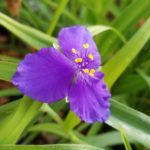 I love our Sweet Kate plant. With some shade and water, it flowers from April to October. Easily grown in average, medium to wet, well-drained soil in full sun to part shade. Prefers moist, acidic, humusy soils. Tolerant of wet, boggy soils. Deadhead each flower cluster after all buds in the cluster have opened to extend the bloom period. As the heat of the summer sets in, foliage tends to decline considerably and flowering slows down or stops entirely, at which point plants should be cut back hard. Cutting back plants almost to the ground will promote both new foliage growth and an additional late summer to fall bloom. Divide clumps when they become overcrowded.
I love our Sweet Kate plant. With some shade and water, it flowers from April to October. Easily grown in average, medium to wet, well-drained soil in full sun to part shade. Prefers moist, acidic, humusy soils. Tolerant of wet, boggy soils. Deadhead each flower cluster after all buds in the cluster have opened to extend the bloom period. As the heat of the summer sets in, foliage tends to decline considerably and flowering slows down or stops entirely, at which point plants should be cut back hard. Cutting back plants almost to the ground will promote both new foliage growth and an additional late summer to fall bloom. Divide clumps when they become overcrowded.
 Our green tomatillo plant is doing great. It is in a 10 gallon pot and has over a hundred husks forming. Tomatillos are related to tomatoes, but their appearance and flavor are markedly different. Tomatillos are round fruits that are covered in a papery husk. They look like hanging lanterns, while growing. As they mature, they completely fill out the husk and it splits open, reveling the plump little fruits inside.
Our green tomatillo plant is doing great. It is in a 10 gallon pot and has over a hundred husks forming. Tomatillos are related to tomatoes, but their appearance and flavor are markedly different. Tomatillos are round fruits that are covered in a papery husk. They look like hanging lanterns, while growing. As they mature, they completely fill out the husk and it splits open, reveling the plump little fruits inside.
 Watsonia bulbs, also known as bugle lily plants, are related to the Lily family and native to South Africa. While they prefer warm climates, they can survive in USDA zone 8. These delicate flowering bulbs usually come in a range of orange and peach hues. As a garden plant, Watsonia blooms in midsummer, providing subtle coloring to a flower border and attracting both hummingbirds and pollinating insects.
Watsonia bulbs, also known as bugle lily plants, are related to the Lily family and native to South Africa. While they prefer warm climates, they can survive in USDA zone 8. These delicate flowering bulbs usually come in a range of orange and peach hues. As a garden plant, Watsonia blooms in midsummer, providing subtle coloring to a flower border and attracting both hummingbirds and pollinating insects.
 Dahlias are tuberous-rooted tender perennials, grown from small, brown, biennial tubers planted in the spring. Dahlias come in a rainbow of colors and even range in size, from the giant 10-inch “dinnerplate” blooms to the 2-inch lollipop-style pompons. Most varieties grow 4 to 5 feet tall. Dahlias brighten up any sunny garden with a growing season that’s at least 120 days long. Dahlias thrive in the cool, moist climates of the Pacific Coast, where blooms may be an inch larger and deeper.
Dahlias are tuberous-rooted tender perennials, grown from small, brown, biennial tubers planted in the spring. Dahlias come in a rainbow of colors and even range in size, from the giant 10-inch “dinnerplate” blooms to the 2-inch lollipop-style pompons. Most varieties grow 4 to 5 feet tall. Dahlias brighten up any sunny garden with a growing season that’s at least 120 days long. Dahlias thrive in the cool, moist climates of the Pacific Coast, where blooms may be an inch larger and deeper.








